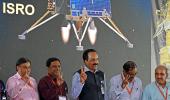The Indian Space Research Organisation (ISRO) successfully launched its third and final developmental flight of Small Satellite Launch Vehicle here on Friday whose payloads can be used in applications like satellite-based surveillance, disaster and environmental monitoring, fire detection, volcanic activity among others.

The flight-LV-D3- would also pave the way for the industry to collaborate with ISRO's commercial arm NewSpace India Ltd for taking up launches using the Small Satellite Launch Vehicle.
As the six-hour countdown for the mission concluded, the LV rocket carrying the primary Earth Observation Satellite EOS-08 lifted off majestically from the first launch pad at the Satish Dhawan Space Centre in Sriharikota, situated about 135 km east of Chennai at a pre-fixed time of 9.17 am and later achieved its mission.
'The third developmental flight ofLV is successful. TheLV-D3 placed EOS-08 precisely into the orbit. This marks the successful completion of ISRO/DOS'sLV Development Project. With technology transfer, the Indian industry and @NSIL_India will now produceLV for commercial missions,' ISRO said in a post on X.
While the maiden mission ofLV in August 2022 did not yield the desired results for the scientists as the launch vehicle did not place the satellites into the intended orbits, the subsequent one,LV-D2-EOS-07 in February 2023 was a success.
ISRO had planned for the latest mission to be launched on August 15 at 9.17 am but it was rescheduled for 24 hours later with a 60-minute launch window.
After a flight of about 10-12 minutes, the primary Earth Observation Satellite got separated successfully. Within a few minutes, a SR-O DEMOSAT Satellite developed by Space Kidz India weighing 200 grams also got separated, signalling the mission's success.
Scientists at the Mission Control Centre congratulated each other on the successful mission, as according to ISRO, it completed the developmental flights ofLV rockets.
Friday's successful mission enables NewSpace India Ltd to commence the dedicated commercial launch of satellites to industry players who are keen to launch satellites weighing up to 500 kg into Low Earth Orbits (LEO) or up to 500 km above Earth.
ALV rocket is shorter at 34 metres (compared to PSLV rockets which are 44 metres tall) and are used to place satellites (mini, micro or nano satellites) that weigh up to 500 kg below 500 km of LEO.
The satellites carried in the mission weigh 175.5 kg and the launch vehicle comprises three solid propulsion stages and a liquid module as a terminal stage.
The key features ofLV vehicles are -- it provides low-cost access to Space, offers low turn-around time and flexibility in accommodating multiple satellites, launch on demand feasibility and demands minimal launch infrastructure.
A former ISRO scientist in a brief interaction with PTI had said the cost ofLV would be around 20-30 per cent lesser than that of a PSLV mission, which uses bigger rockets capable of deep space missions.
"Another point is that if someone plans to launch a satellite in a Low Earth Orbit, it will be possible to launch anLV rocket within two days of planning," he said, indicating the flexibility of the small satellite launch vehicle missions.
He was also of the view that LV rockets are not only used for placing satellites in LEO but also injecting them in the Sun Synchronous Orbit (SSO), based on the demand of a customer.
The primary objectives of the LV-D3 mission are--designing and developing a micro-satellite, creating payload instruments compatible with the micro satellite bus and incorporating new technologies for future operational satellites.
The LV rocket carries three payloads -- Electro Optical Infrared Payload (EOIR), which is designed for use in applications like satellite-based surveillance, disaster and environmental monitoring, fire detection, volcanic activity among others.
The second payload is the Global Navigation Satellite System-Reflectometry (GNSS-R), which would be used for ocean surface wind analysis, soil moisture assessment, cryosphere studies over the Himalayan region, flood and inland waterbody detection.
The final payload is the SiC UV Dosimeter which would monitor the UV irradiance at the viewport of the Crew Module in the Gaganyaan Mission and serve as a high-dose alarm sensor for gamma radiation.
Scientists have planned to place the satellite in a Circular Low Earth Orbit at an altitude of about 475 km with an inclination of 37.4 degree. The satellite mission life is one year.
The EOS-08 mission also marks a significant advancement in satellite mainframe systems such as an Integrated Avionics System known as the Communication, Baseband, Storage and Positioning package which combines multiple functions into a single, efficient unit.
The satellite also includes a structural panel embedded with PCB, an embedded battery, a Micro-DGA (Dual Gimbal Antenna), a Micro-Phased Array Antenna and a flexible solar panel, each serving as a key component for onboard technology demonstration.
In June, NSIL said the LV would have its first dedicated commercial launch when it puts into orbit the Optimus- a satellite built by Australia-based Space Machines Company, in 2026.











 © 2025
© 2025